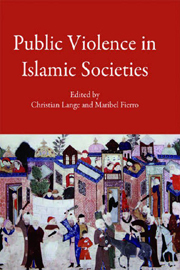 Public Violence in Islamic Societies
Public Violence in Islamic Societies Book contents
- Frontmatter
- Contents
- List of abbreviations
- Acknowledgements
- Introduction: Spatial, ritual and representational aspects of public violence in Islamic societies (7th–19th centuries ce)
- PART I Public violence and the construction of the public sphere
- 1 The case of Jacd b. Dirham and the punishment of ‘heretics’ in the early caliphate
- 2 Qāḍīs and the political use of the maẓālim jurisdiction under the cAbbāsids
- 3 From revolutionary violence to state violence: the Fāṭimids (297–567/909–1171)
- 4 Actions speak louder than words: reactions to lampoons and abusive poetry in medieval Arabic society
- PART II Ritual dimensions of violence
- PART III Representations of public violence
- Index
1 - The case of Jacd b. Dirham and the punishment of ‘heretics’ in the early caliphate
from PART I - Public violence and the construction of the public sphere
Published online by Cambridge University Press: 12 September 2012
- Frontmatter
- Contents
- List of abbreviations
- Acknowledgements
- Introduction: Spatial, ritual and representational aspects of public violence in Islamic societies (7th–19th centuries ce)
- PART I Public violence and the construction of the public sphere
- 1 The case of Jacd b. Dirham and the punishment of ‘heretics’ in the early caliphate
- 2 Qāḍīs and the political use of the maẓālim jurisdiction under the cAbbāsids
- 3 From revolutionary violence to state violence: the Fāṭimids (297–567/909–1171)
- 4 Actions speak louder than words: reactions to lampoons and abusive poetry in medieval Arabic society
- PART II Ritual dimensions of violence
- PART III Representations of public violence
- Index
Summary
Jacd b. Dirham is known in Muslim tradition as an adherent of unorthodox or heretical religious views, executed in Iraq towards the end of the rule of the Umayyad Caliph Hishām b. cAbd al-Malik (r. 105–25/724–43). It is widely reported that his execution took place on the Day of Sacrifices (Yawm, or cĪd, al-Aḍḥā), and usually that the unfortunate Jacd was killed in the same way as the sheep or goats dedicated for slaughter on that day -by dhabḥ: that is, by having his throat cut so as to sever the windpipe and the major blood vessels at the same time.
In most reports of the event, Hishām's governor of Iraq and the East, Khālid b. cAbd Allāh al-Qasrī, is described as having personally killed Jacd in that way in a public gathering. There is some confusion about precisely where it happened, but most accounts favour the mosque of the garrison town of Wāsiṭ. The date is obscure, but since Khālid al-Qasrī was removed from his governorship in 120/738, it could not be later than that. Virtually all the accounts of the event state explicitly that he was killed because of his unacceptable religious views.
If these accounts are taken to reflect a historical event, they raise some questions about the understanding of the Day of Sacrifices in early Islam and about how heretics (or apostates) were dealt with in the late Umayyad period.
- Type
- Chapter
- Information
- Public Violence in Islamic SocietiesPower, Discipline, and the Construction of the Public Sphere, 7th-19th Centuries CE, pp. 27 - 41Publisher: Edinburgh University PressPrint publication year: 2009


